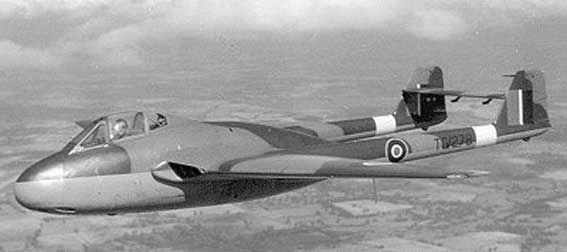

|
Designed to meet Specification E.6/41,the de Havilland "Vampire" was Britain's second turbojet powered fighter to enter service, with the first of three prototype (LZ548/G) taking to the air on the 29/9/1943, piloted by Geoffrey de Havilland Jur, just 16 months after the design work started. The DH-100 was of an all metal construction apart from the cockpit section which was made from ply and balsa wood as in the de Havilland Mosquito, of note was the pod and boom design with the pilot and engine in the pod and the tail unit mounted on twin booms. In May 1944 a contract for 120 "Vampire" Mk I's was placed by the British Air Ministry this was later increased to 300, with the first production aircraft (TG274) being flown on the 20/4/1945. |
 The forth production DH-100 "Vampire" |
 |
A number of changes were made in the first production run, from the 41st aircraft the more powerful "Goblin II" engine making 3,100 lb of thrust was fitted, from the 51st aircraft the cockpit was pressurized and in January 1946 a one-piece canopy was fitted. To late to take part in the Second World War the DH-100 "Vampire" made it's public debut in the fly-over London on the 8/6/1946 by 247 Squadron during the victory celebrations. The British Navy showed an early interest in the "Vampire" and the second prototype (LZ551) was fitted out for deck landing, with longer oleo legs, enlarged flaps and an arrester hook being fitted, trials began on the 3/12/1945, piloted by E.M.Brown on HMS Ocean, renamed "Sea Vampire 10" it was the first pure jet ever to operate from a British carrier. |
|
LZ551 making it's first carrier landing
|